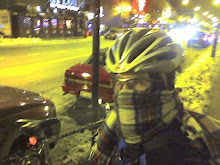
As always...for Katy.
One of the most influential composers upon modern program music - otherwise known as "classical soundtracks" in it's most popular form - was Hector Berlioz (1803-69). He is most well known for the piece I will write about tonight, Symphonie Fantastique (1830). It is so famous, that even if you don't know it by name, you almost certainly will recognize at least part its very memorable melodies and romping bombast.
When it was contemporary, however, Symphonie Fantastique was infamous, and it composer was regarded at best as eccentric and at worst nearly insane. Berlioz was known for adding the most unorthodox instruments to the orchestra, for writing ensembles into existence too big for all but the largest halls, and as a massive egoist in love with his larger than life compositions. But Berlioz's legacy is an important one, just as great and perhaps longer lasting than that of even Beethoven or Mozart - not only did he play a major part in expanding the symphony orchestra as the ensemble we know today, but his ideas continue to shape popular classical music composition even today, music that is meant to tell a visual story as much as an aural one.
Symphonie Fantastique is a love story, written about and for a contemporary Shakespearan actress of the day named Harriet Smithson. Berlioz had fallen in love with her, more like an obsession actually, and composed the piece as an outlet for the frustration of his unanswered love letters. The piece was published with program notes to be read by the audience members at the performance. The music introduces the love interest as the main melodic idea, and then transforms it thematically throughout the entire piece.
Smithson and Berlioz did not actually meet until after she finally heard the piece in 1832 - when she realized she was the genesis. They were married shortly after, but divorced after 9 years.
The recording that I have supplied is actually not the definitive performance, Chicago Symphony Orchestra, Daniel Baremboim, 1994. I recommend Chicago Symphony under Solti, 1972. A much more dynamic and passionate performance, with highly superior strings. Sorry for not providing this, but I only have it on LP. I myself performed this piece, on tuba with the Mississippi Symphony Orchestra in 1995 with my good friend Wade Rackley, also on tuba.
Reveries - Passions
The theme - idee fixe - is introduced immediately, and the lovelorn composer daydreams and muses about her upon first sight, in a slow and meandering adagio, that is expressed with hopeful and muted joy in the violins and horns, but is undercut with an ominous rumbling in the low strings.
Un Bal
The traditional waltz section - or filling the role of the scherzo that was very common in symphonies - further solidifies the visual nature of the piece. The composer has attended a ball and is surrounded by revelers, dancing bodies and rhythmic music, when suddenly he sees her, and all other sensory input stops as she occupies his complete attention - the flute and clarinet rise out of the strings with the already familiar melody.
Scene aux Champs
Our lovelorn hero is in a pastoral field among the sheep and shepherds - another common setting of the day - and sees his love. He calls out to her but she doesn't respond. He tries and tries to get her attention, but she only ignores, and walks off in the distance, leaving him beyond despondent, and suicidal.
Marche au Supplice
Most famously known as "The March to the Scaffold." Our story quickly takes a turn for the tragic. The hero has tried to kill himself by drinking poison, but only succeeds in putting himself into a deep sleep. He dreams that he has killed his love and has been sentenced to the guillotine. He marches along a parade route through screaming throngs of blood thirsty citizens, their voices rising up to life in the low brass. He walks solemnly up the steps, lays his head beneath the blade...yet as the steel glints, hovering above his neck, he has one last, beautiful memory of his love before his head goes bouncing into the basket, and the crowd roars it's approval as his blood sprays a gory red, catching the glaring sunlight.
Songe d'une Nuit du Sabbat
The rollicking finale that truly earned Berlioz his reputation, "The Dream of The Witch's Sabbath" takes us to Hell, where our man's love has transformed into a twisted demon, deformed into a playful, yet unsettling and grotesque version of the original melody, as first played very noticeably by the clarinet. Very importantly, listen to the sinister melody of the Dies Irae. With it, she rouses the witches, monsters, and skeletons (listen to the strings being played on the back of their bows for the creepy effect - a friend said it always reminded him of a swarm of cockroaches) to a wild and cavorting dance of carnal lust that finally collapses in a heap of exhaustion under its cacophonous weight.





No comments:
Post a Comment